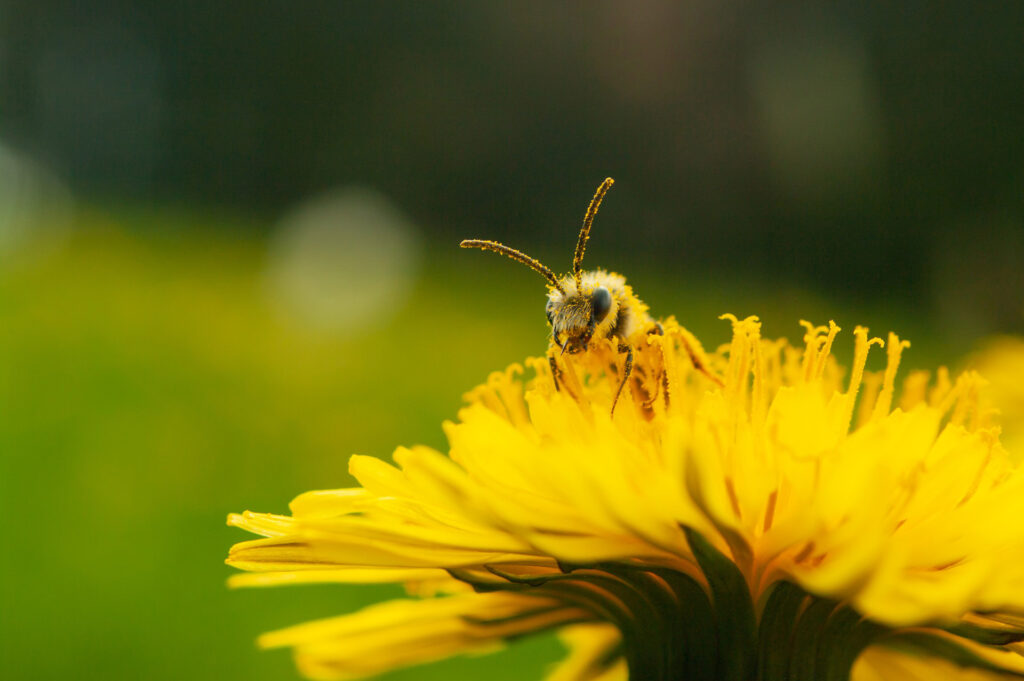
Bees fly up to five miles foraging for their favorite flowers and could make more than 12 trips a day.
The Partial Observer by Steve Davis
No Mow May: One Way to Help Pollinators
May I ask you a favor? It has been a tough winter. My sisters and I have been clustered in a dark, cold hive keeping our queen blanketed within a nice cozy 95°F. We shiver our wing muscles to warm the cluster. Those of us on the outside of the cluster insulate the colony and wait for someone from the center to venture to the outer edge to take our place. Not to get too detailed, but we even hold it for weeks until we get a warm day to fly outside for a bathroom break. I’d like to ask you to NOT do something for me.”
This month is “No Mow May.” This activity was started by Plantlife, an organization in the United Kingdom. It is intended to give emphasis to the role of pollinators in our world. (It also is a chance to reflect on how humans often need to be reminded to be natural!) Bees pollinate about three quarters of the flowering plants in the world. And they pollinate over a third of our food. Most flowers bloom for weeks, not months. Areas of monoculture, many square miles of one crop, make it very difficult for bees to find food throughout the entire growing season. So bees need a variety of plants to maintain a steady flow of pollen and nectar, especially in early spring.
As the “April showers bring May flowers,” we begin our attack on those plants we choose to call weeds. But many of those plants provide valuable resources for pollinators just emerging from winter. The insects are depleted and need all the help they can get. During the summer, a worker bee lives about six weeks. But to survive five months of winter, the honeybee undergoes another of their wondrous adaptations. “Winter bees” are physiologically different and fatter than the summer workers. They contain a protein, vitellogenin, which allows the workers to produce food from their fat bodies even when pollen is not available. So the winter bees collectively hold the energy in their bodies for the survival of the rest of the superorganism.
Once spring arrives, our energy-depleted bees urgently need to find protein from pollen and carbohydrates from nectar. Pollinators begin their search for flowering plants. This is when we can help. Dandelions are a good first start. Let them grow. No, there won’t be mower-shaming attack bees if you clear a little of your lawn. But consider leaving some un-mowed transition areas along hedges. Mow a pathway to an outbuilding instead of the entire lawn. Don’t rely on your neighbor to provide for them. Yes, bees fly up to five miles foraging for their favorite flowers. A foraging bee may visit 50-100 flowers on their trip and make more than 12 trips a day. They will often bypass nearby plants to select some preferred blossoms. But adding your own plantings could reduce their “gas bill,” affording them shorter trips to the store. And, please, don’t use pesticides, as they are a major contributor to the decline in bee population.
The new growing season is a good time for you to help our pollinators feed you. Grow native plants. A good resource is “Native Plants for Pollinators and Beneficial Insects—Northeast, 2023 The Xerces Society for Invertebrate Conservation.” Cornell University also has comparable lists. Select plants that grow well in your planting zone. Don’t forget flowering trees. An American basswood tree can provide bees with as much honey-producing resources as one quarter acre of clover.
One last thing. The bathroom breaks. Honeybees are immaculate housekeepers. They remove dead bees, other insects and debris from their hives. They will go weeks without defecating, waiting for a day over 50°F to make the arduous trip outside for a cleansing flight. And they avoid going in their hive, since it promotes diseases and mold growth. Even the short crawl away from the warmth of the winter cluster can weaken them enough so they cannot make the return trip. So, as the warming spring sun draws them from the hive, let’s make their trip to your flowers a short one.
Give bees a chance. They provide every third mouthful of food you eat. Take a break from mowing. Enjoy a nice tea with honey and be proud of your participation in No Mow May.
To learn more about beekeeping, please visit the Leatherstocking Beekeepers’ Association Facebook page or website, or come to our meetings.
Steve Davis is mentoring coordinator for the Leatherstocking Beekeepers’ Association.

